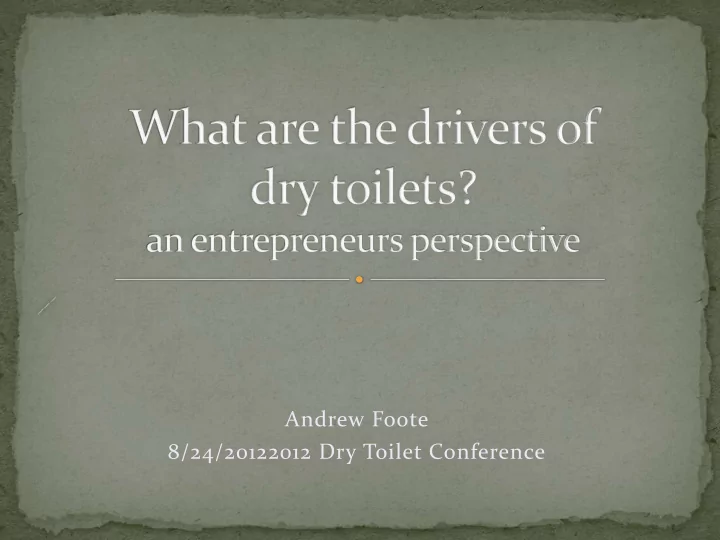

Andrew Foote 8/24/20122012 Dry Toilet Conference
4,000 children a day 2 nd leading cause of death for children under 5 Dying from pathogens in our own shit Issue is exacerbated in urban and peri urban areas Children in the slums of Nairobi, Kenya, have mortality rates much higher than rural Kenyan children (150·6 per 1000 live births vs 113·0, respectively) Urban population in developing countries will double from 2.5 billion in 2009 to 5.2 billion in 2050 165,000 people every day!
What are the drivers of dry toilets? What are the drivers to reduce disease transmission via sanitation interventions?
Prevent interaction with pathogens Minimize interaction and inactivate pathogens Containment Collection BEHAVIOR Treatment CHANGE
Value chain approach CLTS What happens when pit is full? What happens when there is no space to dig a new pit? Waste can be fertilizer? We don’t have small farms for people to use, but we can collect, process, redistribute and sell
Urea fertilizer price locally in Mali is $0.80/kg FOB price $0.30/kg =1kg N is worth $1.74 Jerry can of urine = $0.13 One person 13 days Truck of 11,000 liters is worth only $70
No one likes easting their own shit People like toilets Value chain approach Target reasons why people like toilets Comfort, privacy, safety, dignity, So, it’s simple lets just offer people toilets they like and a system that is sustainable and effective at preventing disease transmission
Ones that are affordable, meet peoples needs and don’t require interacting with shit Latrina Abono Seco Familiar(LASF)=Ecosan=higher disease prevalence Corrales, L.F., Izurieta, R. and Moe, C.L. (2006) Association between intestinal parasitic infections and type of sanitation system in rural El Salvador. Tropical Medicine and International Health. 11 (2): 1821-1831.
Low investment costs are important Ghanasan in-home toilet Sanergy community toilet <$0.05 per use <$0.05 per use Both come with a service so they are maintained and models are financially independent = SCALING
Where does the treatment happen?
Waste treatment system that can integrate into affordable sanitation system where users are buying or renting the toilets because well they like toilets
Sunlight is free! And kills pathogens! Diarrhea due to lack of sanitation Solar Radiation Levels Places where Places where solar sanitation is most radiation is most rare abundant
Sunlight is free! And kills pathogens!
Temperature (C) 100 40 60 80 20 0 02.08… 02.08… Log Inactivation 02.08… 0,5 3,5 2,5 1,5 02.09… 0 2 3 1 02.09… 0 02.09… 02.09… 1 Hours in Solar Concentrator 02.10… 02.10… 2 3 right Axis, center Axis, 4 5 24 48 72
Capital costs are $0.0008 per use
Looking for funding and partners to do large scale pilot in a peri-urban community Once we reach 1,500 households will be financially sustainable based on toilet rental fee
What are the drivers to reduce disease transmission via sanitation interventions? in peri-urban and urban communities Not so much Value from reuse CLTS approach Main drivers Market Affordable solution that treats BOP as costumers and delivers a service that meets needs (privacy, dignity, hygienic, etc) No one likes eating their own shit Low-cost fecal sludge management
Recommend
More recommend